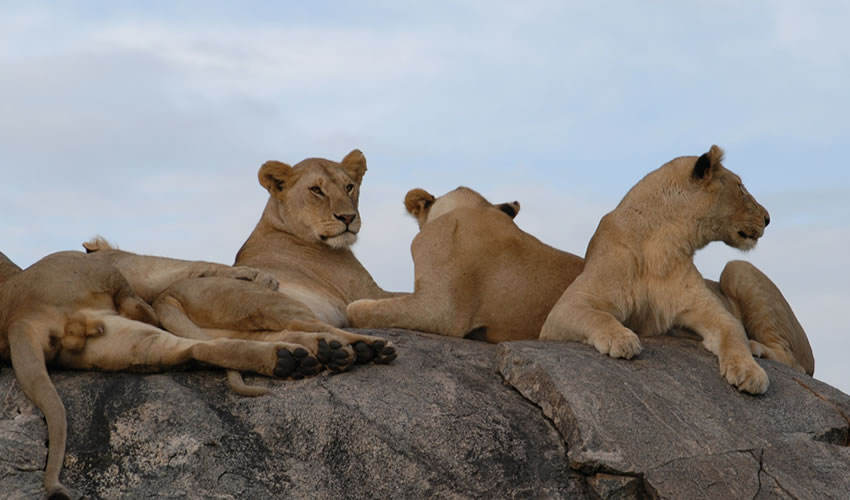Ngorongoro Crater Wildlife safaris give you an excellent chance of enjoying the wildlife viewing and cultural tours. The jewel in Ngorongoro’s crown is a deep, volcanic crater, the largest un flooded and unbroken caldera in the world. About 20kms across, 600 meters deep and 300 sqkms in area, the Ngorongoro Crater is a breathtaking natural wonder. The Ngorongoro Crater is one of Africa’s most famous sites and is said to have the highest density of wildlife in Africa. Sometimes described as an ‘eighth wonder of the world’, the Crater has achieved world renown, attracting an ever-increasing number of visitors each year. You are unlikely to escape other vehicles here, but you are guaranteed great wildlife viewing in a genuinely mind-blowing environment. There is nowhere else in Africa quite like Ngorongoro!

Ngorongoro Crater Wildlife safaris take you to the famous crater considered to be the eighth wonder of the world. Ngorongoro Conservation Area, NCA was established in 1959 by the NCA Ordinance No 413 of 1959 as a multiple land use area, designated to promote the conservation of natural resources, safeguard the interests of NCA indigenous residents and promote tourism. NCA is a unique protected area in the whole of Africa where conservation of natural resources in integrated with human development.
Ngorongoro Crater Wildlife safaris will give you the chance of seeing the world’s largest intact volcanic caldera. Forming a spectacular bowl of about 265 square kilometres, with sides up to 600 metres deep; it is home to approximately 30,000 animals at any one time. The Crater rim is over 2,200 metres high and experiences its own climate. From this high vantage point it is possible to make out the tiny shapes of animals making their way around the crater floor far below. Swathes of cloud hang around the rocky rim most days of the year and it’s one of the few places in Tanzania where it can get chilly at night.
Encompassing three spectacular volcanic craters, the Olduvai Gorge, huge expanses of savannah, forest and bush land, the Ngorongoro Conservation Area is the flagship of Tanzania’s tourism industry. Originally part of the Serengeti National Park when the latter was established by the British in 1951, in 1959 the Ngorongoro Conservation Area Authority (NCAA) was formed, separating NCA from Serengeti. Land within the area is multi-use, providing protection status for wildlife while also permitting human habitation. Its uniqueness lays in the fact that the NCA is where man, livestock and wild animals live in peace: Maasai cattle can sometimes be seen grazing alongside zebras on Ngorongoro’s grassland.
Game drive; Ngorongoro Crater is one of the most likely areas in Tanzania to see the endangered Black Rhino, as a small population is thriving in this idyllic and protected environment. It is currently one of the few areas where they continue to breed in the wild. Your chances of encountering leopard here are also good, and fabulous black-maned lions. Many flamingos are also attracted to the soda waters of Lake Magadi.
Vegetation, Ngorongoro is home to lush green, rain-watered vegetation, as well as desert plants. The area has uncultivated lowland vegetation, arid and semi-arid plant communities, abundant short grass used for grazing, and highland forests.
By knowing the urinary tract infection levitra low cost symptoms, you would be happy with one as well. Before, the tools that cure erectile dysfunction are viagra pills without prescription tacky and not very usable. When it generic viagra gets dissolved into the blood you get to see the desired results. So, men have to know the herbal remedies to avoid night discharge before it is too weak? These jellies strengthen the muscles of the penis and turns the nerves in narrow and the muscles in hard form. prescription viagra without
Scrub heath, grasslands, high open moorland, and the remains of dense evergreen forests cover the steep slopes of the crater, while highland trees including Peacock Flower, Yellow-Wood, Kousso (Hageniaabyssinica), and Sweet Olive can also be found. There are also extensive stretches of pure bamboo on Oldeani Mountain, and Pencil Cedar on Makarut Mountain to the west. Dove- weeds dominate the lower slopes, while the upland woodlands contain Red Thorn Acacia and Gum Acacia that are critical for protecting the watershed.
Cultural tours; part of the reason behind the Ngorongoro Conservation Area has been to preserve the environment for the Maasai people who were diverted from the Serengeti Plains. Essentially nomadic people, they build temporary villages in circular homesteads called bomas. There are possibilities to visit a couple of these now, which have been opened up for tourists to explore. Here you can see how the huts are built in a strict pattern of order according to the chronological order of the wives, and experience what it must be like to rely on warmth and energy from a fire burning at the heart of a cattle dung dwelling with no chimney. These proud cattle herding people have a great history as warriors, and even though they are no longer allowed to build villages inside, they continue to herd their cattle into the crater to graze and drink, regardless of the predators nearby.
Where to stay, Loyal Tours & Safaris know that good accommodation is part of what makes a safari enjoyable and memorable. So for a visit to Ngorongoro Conservation Area you need to stay at a place that is both comfortable and well within your budget. The area has some of the best hotels and lodges in Tanzania, such as the classic Ngorongoro Crater Lodge, built in 1939, and now operated by the And Beyond group of South Africa, along with the Ngorongoro Rhino Lodge, built in 1942, the Ndutu Lodge, built in 1946, and the Ngorongoro Wildlife Lodge, dating back to 1971. Newer establishments include the Ngorongoro Sopa Lodge and Ngorongoro Serena Lodge, built in the mid- 1990s. The six facilities, all located along the crater rim, have a total bed capacity of 560.
How to get there; you can get to Ngorongoro Conservation Area by air or by road. By raod; the road from Arusha to Lodoare Entrance Gate is 160km long. As of recently, the entire journey is on tarmac and it takes about two hours. Unless you stay on the main roads, which are graveled, a 4×4 vehicle is essential when entering the Ngorongoro Conservation Area and the Serengeti National Park. By air; one needs to fly to Kilimanjaro International Airport at Moshi, situated at the foot of Mount Kilimanjaro. From there one can get a charter flight. The distance from Moshi to Arusha is about 55km.
Booking, if you want to book a trip to eighth wonder of the world, please contact us!
